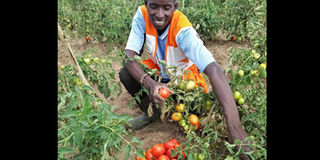Major switch to horticulture from tobacco pays off

Chacha Mwita who has ventured into vegetable farming in Migori. The farmer’s main markets are Isibania, Kehancha and Migori. He further transports the produce to Nairobi on buses plying the Migori-Nairobi route. PHOTO | VIVERE NANDIEMO | NATION MEDIA GROUP
What you need to know:
- The farmer’s main markets are Isibania, Kehancha and Migori. He further transports the produce to Nairobi on busses plying the Migori-Nairobi route.
- Given that cabbages, which grow in well-drained soils with a PH of 6-7, are known to be heavy feeders, the farmer irrigates the crops when rains are erratic and mulches them.
- His efforts have been acknowledged by Migori County Government and World Vision. The former has appointed him an agriculture ambassador, a position he uses to encourage the youth to farm.
The vegetable farm in Kuria East, Migori County located about 7km from Kehancha town stands out in an areas once dominated by tobacco.
The five-acre leased farm owned by Chacha Mwita hosts a variety of crops that include cabbages, tomatoes, indigenous vegetables such as kunde (cow peas), collard greens (sukuma wiki) and capsicum.
The farmer started growing vegetables in 2015 in search of better returns.
“I used to grow maize and tobacco and although they were labour intensive, the returns were little. A visit to a friend in Molo changed my agribusiness,” he said, noting his friend convinced him to switch to cabbages.
During the Seeds of Gold visit, the 37-year-old was busy harvesting cabbages from three-and-half acres.
“I planted about 4,000 heads of the crop. This is the fourth time I am growing cabbages and it’s because of their good returns,” said Mwita, adding he sells each at between Sh30 and Sh70 depending on the size.
The farmer’s main markets are Isibania, Kehancha and Migori. He further transports the produce to Nairobi on buses plying the Migori-Nairobi route.
He starts growing the crop by planting his seeds in a nursery before he transplants to the field.
“The seeds take five to seven weeks in the nursery before they are moved. I then plant the seedlings half-inch deep with a spacing of 50 by 50cm,” explained Mwita.
But before transplanting, the land should be ploughed thrice and be weed-free. Besides DAP, he also uses rabbit urine and droppings as fertiliser.
ENCOURAGE YOUTH TO FARM
Given that cabbages, which grow in well-drained soils with a PH of 6-7, are known to be heavy feeders, the farmer irrigates the crops when rains are erratic and mulches them.
He grows the Gloria F1 variety that takes 80 days to mature and has bigger heads. To keep off caterpillars and aphids, the farmer uses traditional methods that include applying wood on the heads of the cabbages.
Mwita has tomatoes on an acre-and-a-half. On average, he harvests 15 crates after five to seven days, selling each at Sh2,000 to traders from Migori and Kisii markets.
Mwita supplies sukuma wiki to three secondary schools in the area raking in close to Sh60,000 per month.
“I grow the crop traditionally by planting shoots I get from mature plants, which enables me harvest faster,” said Mwita.
His efforts have been acknowledged by Migori County Government and World Vision. The former has appointed him an agriculture ambassador, a position he uses to encourage the youth to farm.
He also works as a trainer of farmers in workshops organised by World Vision.
Kuria East sub county agricultural officer Booker Oloo said soils in the region can support a variety of crops. But noted farmers are reluctant to embrace other crops.
He noted that tomato blight is the most common disease which is manifested by dry brown lesions on stems, leaves and fruits.





